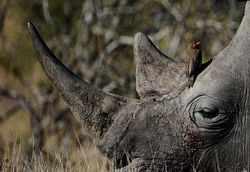
Rhino calves separated from parents during annual floods in the Kaziranga National Park and young rhinos left orphaned by poachers are finding a new home at the Manas National Park, the other world heritage sanctuary in Assam.
Doing this job is the Centre for Wildlife Rehabilitation and Conservation which has completed a decade of its existence in the state.
Director of Kaziranga National Park, N K Vasu, told PTI, "The rehabilitated rhinos are released back to the wild in the Manas National Park in an effort to refurbish the rhino population there after it suffered a near wipe-out a decade ago due to insurgency."
Vasu said the calves were bottle-fed formula milk every two hours until they were around two months old and around a month later they were given bits of grass to nibble at and eventually multigrain supplements.
Initially housed in the indoor nursery for stabilisation for varying periods of time depending on age, the calves are later transferred to one-acre outdoor paddocks within the centre, he said.
Unlike elephant calves that suckle for about three years in captivity, rhino calves get weaned off milk by about 18 months of age and they also start nibbling blades of grass much earlier than elephant calves.
While at CWRC, the calf undergoes treatment for injuries and is carefully nursed back to health by resident vets and keepers and once weaned, the calves are ready for rehabilitation to the release site, Vasu said.
Deccan Herald is on WhatsApp Channels| Join now for Breaking News & Editor's Picks